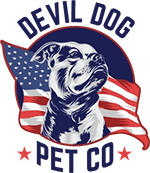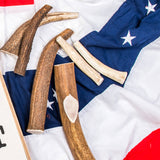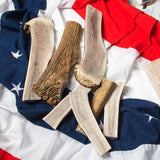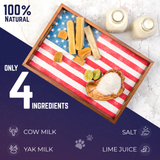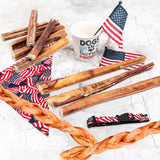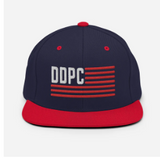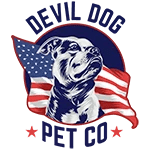Key Takeaways
- Small split elk antler chews are made from naturally shed elk antlers cut lengthwise to expose nutrient-rich marrow.
- These chews are safer and more engaging for puppies' developing teeth compared to whole antlers.
- Choosing the right chew is crucial for your puppy's development and overall behavior.
- Extreme Dog Leadership involves taking full responsibility for what your puppy chews on.
- Providing appropriate chews helps build a foundation for a confident and well-behaved dog.
Table of Contents
- What Are Split Elk Antler Chews?
- Why Size Matters: Puppy Safety Fundamentals
- Puppy-Specific Benefits of Elk Antler Chews
- Selecting the Right Split Elk Antler Chew for Your Puppy
- Split Antlers vs. Other Puppy Chews: The Complete Comparison
- How to Introduce Split Elk Antlers Safely
- Safety Protocols and Supervision Requirements
- Inspection and Replacement Guidelines
- Best Small Split Elk Antler Chews for Puppies
- Where to Buy: Trusted Sources and Shopping Tips
- Conclusion: Lead Boldly, Chew Responsibly
Your puppy just shredded another shoe. Again. Here's the unfiltered truth: Extreme Dog Leadership means taking full responsibility for every detail of your pup's development, including what goes in their mouth. Hand them the wrong chew, and you're setting both of you up for failure. Choose wisely, and you're building the foundation for a confident, well-behaved teammate.
Small split elk antler chews represent the gold standard for responsible puppy ownership. These aren't your typical pet store impulse buys, they're precision-engineered natural tools that serve your pup's developmental needs while keeping your leadership intact. At Devil Dog Pet Co., we've seen too many owners struggle with inappropriate chews that either disappear in minutes or pose safety risks. That stops here.
This guide delivers everything you need to make the right call: safety protocols, sizing science, and the straight talk on why antler chews for dogs outperform synthetic alternatives. We'll cover proper introduction techniques, compare splits against whole antlers, and show you exactly how to match chew hardness to your pup's developmental stage. No fluff, no corporate marketing, just veteran-tested guidance that keeps tails wagging and teeth healthy.
What You'll Learn
- Why split antlers beat synthetic chews for puppy development
- Exact sizing protocols to prevent choking hazards
- When your pup graduates from splits to whole antlers
- Safety supervision techniques that prevent dental damage
- How to source ethically harvested, chemical-free antlers
What Are Split Elk Antler Chews?
Split elk antler chews are 100% naturally shed Rocky Mountain elk antlers that have been cut lengthwise to expose the soft, nutrient-dense marrow core. Unlike whole antlers that present a solid bone surface, splits offer your puppy immediate access to the flavorful interior while maintaining the structural integrity that makes antlers for dogs so durable.
The anatomy of a quality split antler includes three critical components: the dense outer bone wall that provides abrasive cleaning action, the softer marrow core that delivers flavor and nutrients, and the precise cut edges that are hand-sanded for safety. When sourced from naturally shed antlers, these chews contain no artificial additives, chemicals, or preservatives, just pure bone and marrow as nature intended.
This design serves multiple purposes in puppy development. The exposed marrow immediately captures attention and rewards chewing behavior, while the harder outer sections provide the dental benefits and mental stimulation that growing dogs crave. The result is a chew that bridges the gap between soft puppy toys and the hardcore whole antlers your dog will graduate to as an adult.
For those seeking a premium option, consider the small split elk antler chews for puppies that are specifically sized and crafted for developing mouths.
Why Size Matters: Puppy Safety Fundamentals

Here's where most owners mess up: they size antler chews based on their puppy's current weight instead of jaw dimensions. Are antlers safe for dogs? Absolutely, when you choose the right size and supervise properly. Get the sizing wrong, and you're creating a choking hazard or dental emergency.
A "small" split antler chew typically measures 4-6 inches in length with a diameter appropriate for puppies under 25 pounds. However, the critical measurement isn't length, it's the relationship between the antler's thickness and your puppy's mouth. The chew must be longer than your pup's muzzle and too thick to fit between the back molars where maximum crushing force occurs.
Sizing Protocol
Measure your puppy's lower jaw from nose to the back of the mouth. Add 2 inches to that measurement for minimum antler length. For thickness, the antler should be wider than the gap between your pup's back teeth when the mouth is partially open.
The science behind proper sizing centers on bite mechanics and swallowing reflexes. Puppies explore the world through their mouths, and their natural instinct is to test whether objects fit down their throat. An appropriately sized antler chew physically cannot be swallowed whole, forcing your pup to engage in the slow gnawing behavior that provides dental and mental benefits.
When in doubt, size up. A slightly oversized antler chew poses minimal risk and will last longer as your puppy grows. An undersized chew becomes a projectile hazard that can lodge in the throat or cause intestinal blockage if swallowed. This isn't negotiable, your pup's safety depends on getting this measurement right.
For more sizing options, explore the chews designed for puppies 5-25 lbs to ensure a safe fit for your dog's jaw size.
Puppy-Specific Benefits of Elk Antler Chews
Split elk antlers deliver targeted developmental support that synthetic chews simply cannot match. The mineral profile reads like a puppy multivitamin: calcium and phosphorus for bone development, magnesium for muscle function, and zinc for immune system support. These aren't added supplements, they're naturally occurring minerals locked in the antler's bone matrix.
The dental health benefits start immediately. As your puppy gnaws the split antler, the abrasive action scrapes away soft plaque before it hardens into tartar. The exposed marrow provides gentle resistance that strengthens jaw muscles without overwhelming developing teeth. Unlike rawhide or synthetic chews that can soften and stick to teeth, antler chews maintain their structure throughout the chewing session.
Mental stimulation ranks equally important for growing minds. Antler dog chews provide what behaviorists call "species-appropriate enrichment", the type of extended chewing activity that wild canids engage in naturally. This focused gnawing releases endorphins that promote calm behavior and reduce anxiety, making antler chews particularly valuable during crate training or when managing separation stress.
The practical advantages matter just as much to owners. Elk antlers produce minimal odor, create virtually no mess, and won't stain carpets or furniture. They don't require refrigeration, won't spoil if left out, and maintain their appeal for weeks or months depending on your puppy's chewing intensity. Compare that to the constant replacement cycle and cleanup requirements of most puppy chews.
For a deeper dive into the pros and cons of different antler types, check out this comprehensive comparison of deer antler vs elk antler for dogs.
Selecting the Right Split Elk Antler Chew for Your Puppy

Choosing the correct small split elk antler chews for puppies requires a systematic approach that prioritizes safety over convenience. Most owners make critical errors in this selection process, leading to dental emergencies or choking incidents that could have been prevented with proper guidance.
The sizing protocol starts with jaw measurement, not body weight. Measure from your puppy's nose to the back of their mouth, then add 2 inches for minimum antler length. For thickness, the antler must be wider than the gap between back molars when your pup's mouth is partially open. This prevents the dangerous scenario where an antler becomes lodged between teeth or gets swallowed whole.
Split variations matter significantly for different chewing styles. Standard splits work well for moderate chewers, while base-cut splits (retaining the burr end) provide extra grip and longevity for persistent gnawers. The exposed marrow should appear fresh and light-colored, avoid any splits with dark, dried-out marrow that indicates poor storage or age.
Pro Sizing Tip
When uncertain between two sizes, always choose the larger option. Your puppy will grow into it, and oversized antlers pose minimal risk compared to undersized ones that can become projectile hazards.
Quality indicators include smooth, hand-sanded edges, uniform coloring, and dense bone structure without visible cracks or soft spots. Avoid splits that feel lightweight for their size, this suggests poor mineral density that leads to rapid wear and potential splintering. The best antler chews for dogs maintain their structural integrity throughout extended chewing sessions.
If your puppy is ready to graduate, consider the extra small whole elk antlers dog chew for a denser, longer-lasting alternative.
Split Antlers vs. Other Puppy Chews: The Complete Comparison
Understanding how split elk antlers stack against alternatives helps you make informed decisions based on your puppy's specific needs and your leadership priorities. This comparison cuts through marketing hype to deliver the tactical intelligence you need.
| Feature | Split Elk Antler | Yak Chews | Bully Sticks | Rawhide | Synthetic Chews |
|---|---|---|---|---|---|
| Hardness Level | Moderate (marrow exposed) | Hard initially, softens | Moderate, softens quickly | Variable, often soft | Variable by material |
| Puppy Safety | High with proper sizing | High, fully digestible | High, fully digestible | Poor, blockage risk | Depends on material |
| Longevity | Weeks to months | Days to weeks | Minutes to hours | Hours to days | Variable |
| Odor Level | Virtually none | Minimal | Moderate to strong | Often strong | Usually none |
| Mess Factor | Minimal dust only | Light crumbs | Can be greasy | Often messy | Usually clean |
| Nutritional Value | High minerals, low calories | Protein, moderate calories | High protein, higher calories | Minimal nutrition | None |
| Cost Per Hour | Excellent value | Good value | Poor value | Variable | Good to excellent |
The comparison reveals why experienced dog handlers gravitate toward natural chews for developmental support. Yak chews for puppies offer excellent digestibility and moderate longevity, making them ideal rotation partners with split antlers. Bully sticks provide immediate gratification but disappear quickly, serving better as high-value training rewards than daily enrichment tools.
Rawhide presents the highest risk profile with poor digestibility and frequent contamination issues from chemical processing. Synthetic chews vary wildly in quality and safety, with many containing questionable materials that offer no nutritional benefit. The clear winner for sustained enrichment and developmental support remains naturally sourced, properly sized split elk antlers.
For more on the safety and benefits of antlers, see this blog post on whether antlers for dogs are a good idea.
How to Introduce Split Elk Antlers Safely

The introduction process determines whether your puppy develops healthy chewing habits or creates problems that require correction later. Extreme Dog Leadership means controlling every variable during this critical learning phase.
Start by rubbing a small amount of high-value food on the exposed marrow, peanut butter, bone broth, or even a bit of wet food works effectively. This creates immediate positive association while encouraging proper gnawing technique. Hold one end of the antler while your puppy explores, praising calm, controlled chewing behavior.
Limit initial sessions to 10-15 minutes maximum. This prevents jaw fatigue, reduces the risk of stomach upset from rich marrow, and maintains novelty value for future sessions. Remove the antler while your puppy is still interested, this creates anticipation and prevents the chew from becoming background furniture.
Monitor chewing style closely during early sessions. Encourage side-gnawing by positioning the antler horizontally and redirecting any attempts to bite straight down with maximum force. Puppies that persistently try to crack the antler with their back molars may need to wait a few more months before graduating to this level of chew hardness.
Store the antler in a dry location between sessions, checking for any changes in structure or appearance. Fresh antlers maintain their appeal for extended periods when properly cared for, making them exceptional value compared to single-use alternatives.
For a full selection of split antler options, browse the split elk antler collection to find the right match for your puppy's needs.
Safety Protocols and Supervision Requirements
Supervision isn't optional, it's the cornerstone of responsible antler chew management. Even perfectly sized antlers require active oversight to prevent the rare but serious complications that can occur with any hard chew.
Direct visual supervision means staying within arm's reach during chewing sessions, not scrolling your phone while your puppy gnaws in the corner. Watch for signs of aggressive chewing that could damage teeth: excessive force, attempting to crack the antler, or trying to swallow large pieces. These behaviors indicate your pup isn't ready for this level of chew hardness.
Inspection and Replacement Guidelines
Regular inspection prevents emergency vet visits and ensures your puppy's chewing sessions remain safe and productive. Antlers for dogs require systematic evaluation after each use to identify wear patterns that could compromise safety.
Check for structural changes after every chewing session. Fresh antlers maintain their dense, uniform appearance with smooth marrow surfaces. Warning signs include hollow sounds when tapped, visible stress fractures, or marrow that appears dried and crumbly. These indicate the antler has reached the end of its safe service life.
Size reduction happens gradually but requires vigilant monitoring. Most small split antlers serve puppies safely for 3-6 weeks with regular use, depending on chewing intensity and frequency. Power chewers may need replacement sooner, while gentle gnawers can safely use properly maintained antlers for months.
Surface texture changes also signal replacement time. Smooth, polished areas where your puppy consistently chews indicate normal wear. However, rough, splintered sections or areas where the bone structure appears compromised require immediate retirement. The investment in a new antler far outweighs the risk of dental damage or choking incidents.
Storage between sessions affects longevity significantly. Keep antlers in dry, well-ventilated areas away from moisture that can soften the bone structure. Avoid storing in plastic bags or airtight containers that trap humidity and promote bacterial growth.
For more expert guidance on safe introduction and benefits, consult this complete guide to safe introduction and benefits of antler chews for puppies.
Best Small Split Elk Antler Chews for Puppies
Not all antler dog chews meet the rigorous standards required for safe puppy development. These top-tier options represent the gold standard for quality, safety, and ethical sourcing that responsible owners demand.
Devil Dog Pet Co. Small Split Elk Antler - Premium Grade
Best for: Puppies 5-8 months with emerging adult teeth
Rating: 5/5 stars
Hand-selected from naturally shed Rocky Mountain elk antlers, these splits undergo rigorous inspection before reaching your puppy. Each piece is cut lengthwise to expose nutrient-rich marrow while maintaining structural integrity that prevents dangerous splintering. The veteran-owned sourcing process ensures traceability from wilderness collection through final packaging.
If you want a premium, safe chew for your puppy, try the extra small split elk antler dog chew - 2 pack for the youngest chewers.
Pros
- 100% naturally shed, never farmed
- Hand-sanded edges for safety
- 30-day satisfaction guarantee
- Supports veteran and rescue causes
- Minimal odor and mess
Cons
- Higher upfront cost than synthetic alternatives
- Requires proper sizing knowledge
Whole Elk Antler Alternative - Dense Core
Best for: Puppies graduating to harder chews
Rating: 4/5 stars
Whole antlers provide maximum longevity but require careful size selection for puppy safety. The dense outer wall forces slower consumption while delivering extended enrichment value. Best reserved for puppies demonstrating mature chewing habits and fully erupted adult teeth.
For a whole antler option, consider the small whole elk antler dog chew for puppies ready to advance.
Other Split Options - Budget Choice
Best for: Cost-conscious owners seeking basic functionality
Rating: 3/5 stars
Generic split antlers from various suppliers offer lower costs but sacrifice quality control and sourcing transparency. While functional for basic chewing needs, they lack the consistent sizing and safety standards that premium options provide. Suitable for experienced owners comfortable with variable quality.
Where to Buy: Trusted Sources and Shopping Tips
Source selection determines whether you receive premium, safely processed antlers or questionable products that could endanger your puppy. Are antlers safe for dogs depends entirely on sourcing, processing, and quality control standards that vary dramatically between suppliers.
Purchase directly from Devil Dog Pet Co. for guaranteed quality, transparent sourcing, and veteran-backed customer service. Our warehouse inspection process catches defects that automated systems miss, while our satisfaction guarantee removes purchase risk entirely. Free shipping on orders over $35 makes stocking up economical for multi-dog households.
Essential questions for any supplier include antler origin (wild-shed vs. farmed), processing location, quality control procedures, and return policies. Legitimate suppliers provide detailed answers and welcome questions about their sourcing practices. Evasive responses or vague marketing language indicate potential quality issues.
Bulk purchasing makes sense for households with multiple puppies or those planning long-term use. However, avoid stockpiling from unproven suppliers until you've tested their quality with smaller orders. The best antler for dogs comes from suppliers who prioritize safety over profit margins.
For answers to common questions about antler chews, visit this external FAQ resource for additional insights.
Conclusion: Lead Boldly, Chew Responsibly
Choosing small split elk antler chews for puppies represents more than product selection, it demonstrates your commitment to Extreme Dog Leadership principles that prioritize long-term development over short-term convenience. Every decision you make during your puppy's formative months shapes their future behavior, health, and relationship with you.
The evidence overwhelmingly supports naturally sourced, properly sized split elk antlers as the superior choice for puppy enrichment and dental development. Their combination of safety, longevity, and nutritional benefits outperforms synthetic alternatives while supporting ethical sourcing practices that protect wildlife habitats.
Your puppy depends on your leadership to make informed decisions about their safety and development. Half-measures and convenience shortcuts create problems that require expensive corrections later. Invest in quality now, supervise properly, and watch your puppy develop healthy chewing habits that last a lifetime.
At Devil Dog Pet Co., we equip responsible owners with the tools and knowledge needed to lead effectively. Our small split elk antler chews for puppies represent the gold standard for safety, quality, and ethical sourcing that your developing companion deserves. Choose to lead, your puppy's future depends on the decisions you make today.
Download the FREE 10-Step Dog Prep Guide
Frequently Asked Questions
Are antler chews suitable for puppies?
Antler chews can be suitable for puppies, but only when introduced carefully and at the right developmental stage. Small split elk antler chews expose the softer marrow, which is gentler on puppy teeth and provides a tasty reward, making them a good starter option once adult teeth begin to come in. Always supervise your puppy during chew sessions to prevent tooth damage or choking.
At what age can puppies chew their antlers?
Puppies should wait until their adult molars have erupted, typically around 5 months of age, before chewing on full-strength antlers. Before this milestone, their baby teeth and developing jaws are too fragile for hard chews. Introducing small split antlers with exposed marrow around this time, in short, supervised sessions, is a safer way to start.
Can my puppy eat an antler?
While puppies lick and gnaw on the exposed marrow of split antlers, swallowing large chunks of antler bone is unsafe. The antler itself is not edible like a meat chew and can cause dental damage or choking if broken into small sharp pieces. Always size the chew properly, supervise closely, and remove the antler once it becomes small enough to swallow.
What is a safe chew for puppies?
Safe chews for puppies are those that match their jaw strength and dental development, such as oversized split antlers with exposed marrow or Standard bully sticks. These options provide engagement and help soothe teething discomfort without risking tooth fractures. Keep chew sessions brief and always supervise to ensure safety.
Why can't puppies have antlers?
Puppies can’t have full-strength whole antlers early on because their baby teeth and developing jaws aren’t equipped to handle the extreme hardness, which can lead to cracked or broken teeth. Additionally, aggressive chewing on dense antlers before adult teeth emerge may cause pain and dental injury. Waiting until adult molars come in and starting with gentler split antlers protects your puppy’s oral health.
